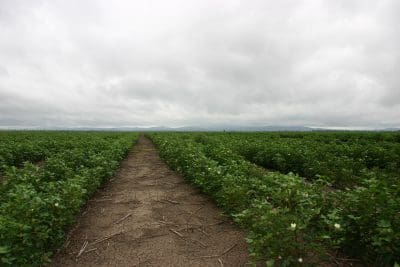RAIN forecast this weekend is likely to trigger another round of sowing that will top off one of the biggest dryland cotton plantings in years across the northern farming zone of eastern Australia.

High subsoil moisture levels and attractive price comparatives have enticed many growers to re-introduce rain-fed cotton into their summer rotations this season. Photo: Cotton Australia
With soil moisture profiles already topped up by recent rains and with more to come, the scene is set for rain-fed cotton to play a bigger part in summer cropping rotations than it has for several seasons.
While moisture holds the key, many growers who would normally grow sorghum are also drawn to cotton because of current pricing around $500/bale while sorghum languishes at $200/tonne, about $100/t less than the same time last year.
Cotton Seed Distributors extension and development agronomist, James Quinn, Moree, NSW, said there had already been significant areas of rain-fed cotton planted and another rain event forecast for this weekend would bring the rest online.
“For people who are in areas that were a bit marginal or were waiting for things to warm up, they will have an opportunity to have a good crack at it and be able to plant when the profile is full,” he said.
“I think we are just about to hit the sweet spot. If you are not going to go now you will never go.”
Heightened interest
MCA agricultural consultant, Tim Richards, Goondiwindi, Qld, said there had been an increase in interest in dryland cotton this year throughout the Darling Downs and North West NSW.
“The most important thing is a good soil moisture profile. That is rule number one. There is a good soil moisture profile which is the main driving factor among our clients,” he said.
“Price is definitely part of the discussions, but they are a long way off selling any cotton they are planting so we try not focus on price as the primary reason for changing. But it is certainly causing people to swing more to cotton than sorghum.”
Mr Richards said the increased interest was mainly from producers who had grown the crop before and maintained it as an option in their cropping programs “when things line up”.
“There are new growers, but not a lot. There are certainly return growers. Back in 2010-2013 where we had large dryland areas, a lot of those people haven’t had the opportunity to plant in the last two years because poor soil moisture profiles or lack of spring rain. They have returned, and there is a scattering of new growers,” he said.
Planting opportunity
“The other driving factor is the opportunity to plant. They have had a lot of area put aside for dryland cotton in the last couple of years but they haven’t had a good opportunity to plant.
“They have had a chance to get a good chunk in over the last 10 days and with the weather forecast for rain on the weekend they will potentially get the rest in. With rain on the weekend we should see most of the area go in.”
Get our free daily cropping news straight to your inbox – Click here
In Central Queensland where dryland cotton sowing can be split between early and late plant, some early plant has gone in.
Planting is well underway on the Darling Downs in southern Queensland where conditions have been ideal, while plantings have been more sporadic in the Gwydir, Namoi and Macquarie valleys of NSW where over-wet conditions have interfered with planting opportunities.
There is a stretch of country in the shadow of the Warrumbungles in North West NSW that grew dryland cotton many years ago and has come back into production this season.
Mr Quinn said dryland growers should ensure they had plans in place for the whole season.
“The main thing is to get your ducks in a row and make sure you have everything organised, even to the point of organising a picking contractor,” he said.
“You should be aiming to be planting on a full profile and getting a good, even plant stand – if you can do that, they are the things you can control. Then it is up to Mother Nature to rain.”

HAVE YOUR SAY